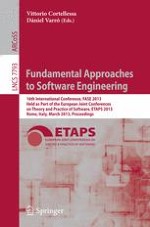2013 | Book
Fundamental Approaches to Software Engineering
16th International Conference, FASE 2013, Held as Part of the European Joint Conferences on Theory and Practice of Software, ETAPS 2013, Rome, Italy, March 16-24, 2013. Proceedings
Editors: Vittorio Cortellessa, Dániel Varró
Publisher: Springer Berlin Heidelberg
Book Series : Lecture Notes in Computer Science
